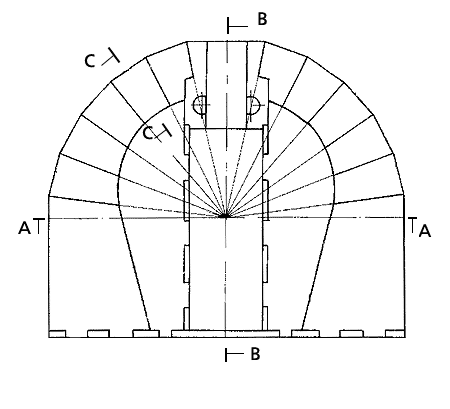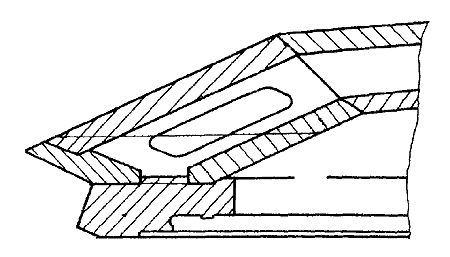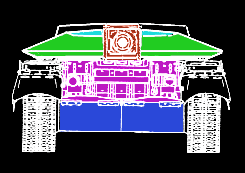



As the tank design is not complete yet, it is impossible to tell what would be used in the final package. However, thanks to a recently released patent on the turret (RU 2169336 C2), there is a chance to come up with a rough idea of possible protection levels. The estimates presented below are based on extremely conservative assumptions, that essentially rely on circa 1987 protection levels and can be put in place without any additional R&D allocation whatsoever. It is unlikely that the finished vehicle is less protected, and quite likely it is protected better.
 |
| Black Eagle turret top view |
 |
| Cut across A-A plane (rear of frontal array) |
 |
| Cut across B-B plane (axis of symmetry through the gun compartment) |
 |
| Cut across C-C plane (cutaway of one of the frontal sections) |
According to the patent and based on the estimated turret ring diameter of 2.5m (like on T-80U), the frontal section consists of a frontal plate 80-100mm thick, followed by 170mm insert, and 60mm back plate, inclined at up to 70°. The roof section has a frontal plate 60mm thick, 100mm insert, and 40mm back plate, inclined at 84-86°.
Considering an obvious similarity of this array to the traditional glacis of late Soviet tanks, let's assume an insert similar to T-80U glacis. Again, this is nothing but an estimate of armor potential using the technology that is immediately available.
The T-80U glacis insert is presumably made up of 30mm sheets of armor glass fiber (STB) interleaved by 5mm steel. STB in this layout offers TE of 0.45 vs KE and 0.75 vs HEAT, and it should be possible to place 5 STB plates in the front array and 3 plates in the top one.
It has always been intended to add ERA above the main armor and indeed armor shape lends nicely to this. Let's assume "Kaktus" ERA developed by NII Stali and demonstrated on the recent shows (increase of APFSDS protection up to 1.6 times and HEAT protection up to 2 times)
Glacis thickness is unknown, but it is expected to be considerably thicker thanks to extra hull length offered by an additional roadwheel. However we will refrain from any hypothesizing for the time being, as the new hull with reconfigured front has not been presented yet.
Lower hull probably remains 80mm RHA preceded by 10mm HHS dozer blade inclined at 64° (LOS modifier of 2.28) or 21cm KE and HEAT armor, plus a rubber flap typical of T-80U that may offer some small extra HEAT protection (4-5cm).

| Mantle thickness UNKNOWN, but probably only provides protection against autocannons as hit there is limited to firepower kill. | |
|
[80-100mm RHA + 30mm STB x 5 (x 0.451) + 5mm RHA x 4 + 60mm RHA] / cos 70° = 468-526mm (RHA) + 198mm (STB) = 666-724mm plus "Kaktus" ERA (x1.6) = 107-116cm KE.
[80-100mm RHA + 30mm STB x 5 (x 0.751) + 5mm RHA x 4 + 60mm RHA] / cos 70° = 468-526mm (RHA) + 328mm (STB) = 796-854mm plus "Kaktus" ERA (x2.0) = 159-171cm HEAT. |
|
|
[60mm RHA + 30mm STB x 3 (x 0.451) + 5mm RHA x 2 + 40mm RHA] = 110mm (RHA) + 41mm (STB) = 151mm plus "Kaktus" ERA (x1.6) = 24cm KE & EFP.
[60mm RHA + 30mm STB x 3 (x 0.751) + 5mm RHA x 2 + 40mm RHA] = 110mm (RHA) + 68mm (STB) = 178mm plus "Kaktus" ERA (x2.0) = 36cm HEAT. This is against top-attack weapons attacking at exactly normal to armor (i.e. 4-6° from vertical). For angled hits typical of most top-attack weapons this needs to be adjusted to LOS thickness. For frontal hits, this is an impossible target as LOS modifier is close to 10. |
|
| Glacis armor UNKNOWN. | |
| 21cm KE and 25-26cm HEAT | |
| Side turret in the frontal section has the same protection as the front; autoloader/magazine judging by the patent is only protected from autocannon ammo. | |
| The side hull is probably the same 8cm thick RHA; side skirts add 25 mm thick reinforced rubber with backing steel plate plus 60cm airgap increasing the HEAT armor by about 15-17cm against 2nd gen and 26-28cm against 1st gen warheads. This steel/rubber skirt will add at least 5cm to the KE side armor, due to deflection. In addition, the first 2/3 of the hull is protected by heavy ERA screens which probably adds about x1.1 KE and x1.5 HEAT resistance when struck at normal, and x1.2/x2.0 if struck at 30°. |
| 1 - | Adjustment for thickness effectiveness relative to RHA. |

This page is © 2005 Vasiliy Fofanov.